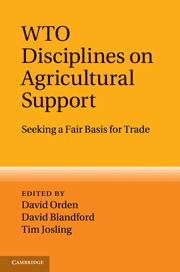Book contents
- Frontmatter
- Contents
- List of figures
- List of tables
- Notes on contributors
- Preface
- List of acronyms
- PART I overview of domestic support issues and WTO rules
- PART II Developed countries: have high levels of support come down?
- PART III Developing countries: will low levels of support rise?
- 7 Brazil
- 8 India
- 9 China
- 10 Philippines
- PART IV Looking forward: can fair markets be achieved?
- Appendix A Domestic support provisions of the Agreement on Agriculture
- Appendix B Domestic support provisions of the Doha draft modalities
- Index
- References
8 - India
Published online by Cambridge University Press: 11 April 2011
- Frontmatter
- Contents
- List of figures
- List of tables
- Notes on contributors
- Preface
- List of acronyms
- PART I overview of domestic support issues and WTO rules
- PART II Developed countries: have high levels of support come down?
- PART III Developing countries: will low levels of support rise?
- 7 Brazil
- 8 India
- 9 China
- 10 Philippines
- PART IV Looking forward: can fair markets be achieved?
- Appendix A Domestic support provisions of the Agreement on Agriculture
- Appendix B Domestic support provisions of the Doha draft modalities
- Index
- References
Summary
The objective of this chapter is to update the WTO domestic support notifications of India and place them in the context of the Agreement and Doha proposals for further reform. India notified its domestic support to the WTO for 1997/98 in June 2002 and had not submitted any further domestic support notifications as of June 2010. Shadow notifications provide updates on domestic support measures and their components for 1998/99 through 2005/06. Preliminary estimates or forecasts of shadow support are provided for 2006/07 to 2008/09 along with a projection of major support aggregates for 2015/16.
I begin with an overview of agriculture within the Indian economy and key agricultural trade and domestic policies. The section that follows details the domestic support notifications of India with my understanding of how each component is derived. In the following section, I employ this understanding of the methodology from the last notification to sketch the shadow notifications. The information should be interpreted as a best assessment of how India's domestic support might be notified given an understanding of its past notifications. Finally, with a projection for 2015/16, I discuss how the Agreement, or a possible Doha outcome, is likely to impact Indian policies and domestic support measurements. This gives some insights on the future of Indian farm policy.
- Type
- Chapter
- Information
- WTO Disciplines on Agricultural SupportSeeking a Fair Basis for Trade, pp. 277 - 309Publisher: Cambridge University PressPrint publication year: 2011
References
- 4
- Cited by

